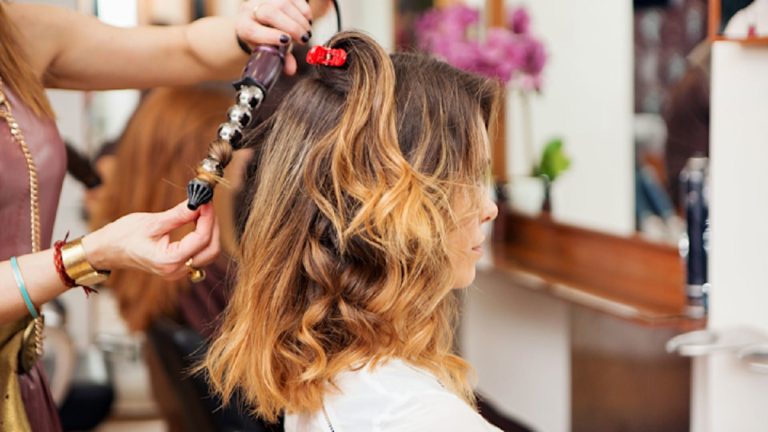How To Take Off Dip Powder Nails Without Acetone?
Acetone is like a captain in the world of solvents since it’s super strong enough to dissolve a variety of chemicals easily. Hence for dip manis removal, this is mostly recommended.
Then again, sometimes, you simply want to skip acetone. It can be for allergy or availability issues. In that case, how to remove dip powder nails without acetone?
The good news is, there are some good alternatives to acetone like acetone-free remover, isopropyl alcohol and white vinegar that can weaken dip powder nails so they can be taken off.
You mainly need a good solvent that can break down the chemicals. Since non-acetone remover, alcohol and vinegar have similar dissolving properties like acetone, they can be effective substitutes. Just remember that those three are not as powerful as acetone, so it can be time-consuming.
Tools like cuticle pusher and file are also effective for removing the softened dip nails and residues. They can be used after the liquid methods or individually.
However, let’s know about all the alternatives and how they can help you take off your dip mani.
How Do You Remove Dip Powder Nails Without Acetone? [5 Easy Ways]
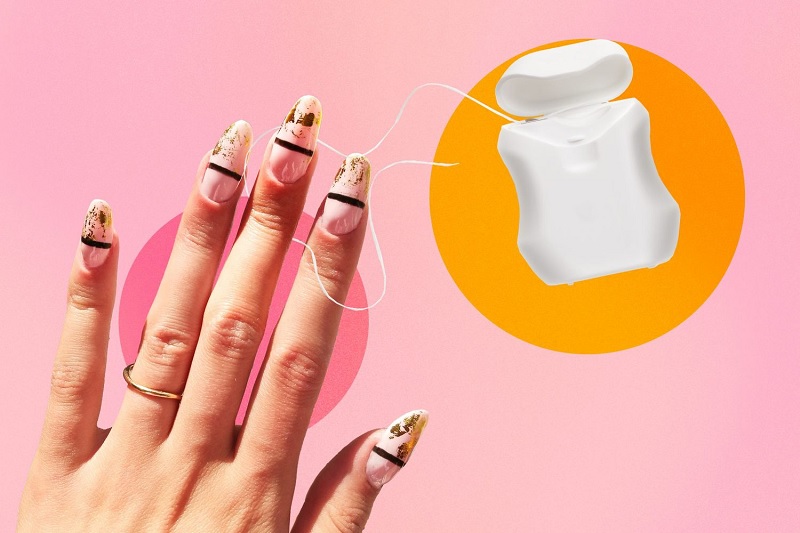
Dip powder nails can be removed without acetone using cuticle pusher, buffer, acetone-free remover, isopropanol or white vinegar.
You can try them individually or combine the methods such as weakening the dip nails with vinegar or alcohol and then file the softened structure and residues.
However, let’s explore these 5 options to kick that dip nails to the curb.
1. Cuticle Pusher
A cuticle pusher or orangewood stick can be an effective tool to take off dip powder nails without acetone only if there’s a base coat used underneath. In that case, it’s a must to know the right technique to do it. When you apply pressure to the areas of dip nails, you could slip and end up hurting your nails or skin if you aren’t careful.
Since it’s slightly tricky to use the tool to remove dips, it may take a couple of rounds to see success. Before opting for this method, you have to wait and find a weak spot where there might be a bit of lifting. It’s easier to notice the lifting when lighter dip powder nails are used.
How To Take Off Dip Powder Nails With Cuticle Pusher?
- Start with the side of the nail.
- Look for any separation from the dips to enhancement or gel tips.
- Apply pressure to that separation area.
- The dip nails should pop off.
It’s not recommended to go in from the cuticle line otherwise you run a higher risk of getting cuticle pusher under the enhancement or the skin itself.
In case the dips are stubborn enough to pop off, then try vinegar or isopropyl alcohol.
2. Filing tool
Filing tool can work effectively to remove dip powder nails without acetone. It mainly helps thin out the dip nails to the point where they can be easily softened when soaked in warm water. However, the range of efficiency depends on what filing tool is used. A regular file will take longer time than e-file. So, it’s suggested that an e-file is used.
Make sure you use filing tool only when there’s builder gel underneath the dip powder nails or else it may damage your natural nail.
Use a coarse grit e file as you just want to file the top layer and not the layers below it. You can consider using HoMove e-file combined with Pana Small Barrel Silver Carbide Bit Medium Grit.
How To Remove Dip Powder Nails With Filing Tool?
- Apply a very light pressure and buff the nails gently at the slowest possible speed. If you’re a pro, you can increase the speed slightly.
- File back and forth, then side to side but make sure to go upward toward the tips and not downward towards cuticles as the file may hurt them.
- Work out in one area for a while and then move to another area. Since the drill machine can generate heat, if you feel a bit of warmth, switch to a new spot.
- It may take an hour to buff the dip powder nails. So, make sure to be patient and avoid going wild.
- In case you still see some dip powder parts stick to your nails, soak them in hot water to soften them.
- Next use cuticle pusher to take them out.
Do wash your hands properly and apply some moisturizer or cuticle oil.
3. Use Acetone-Free Nail Polish Remover
Non-acetone polish remover can work to take off dip powder nails as it has active chemicals to do the job. The main chemical in acetone-free remover is ethyl acetate that’s quite a stronger solvent than rubbing alcohol and vinegar even for the dip products.
So, when it comes in contact with the mani, the to the point where they can be taken off.
It has 60-81% ethyl acetate which is pretty much enough for the chemicals in dip powder to break down to the point where they can be taken off.
But make sure to use a small amount of the liquid otherwise it might affect the enhancement or tips too.
How To Remove Dip Powder Nails With Acetone-Free Remover?
- Roughen the surface of top coat with a file.
- Soak the cotton balls in remover.
- Wrap the balls around the nails with aluminum foil.
- Soak for 15-20 minutes or until the dip powder softens.
- Use orangewood stick or cuticle pusher to gently scrape the softened powder off.
- Repeat it 3-4 times if needed.
Make sure to wash hands and apply some moisturizer or cuticle oil since such removers dry out the skin.
4. Isopropyl Alcohol
Isopropyl Alcohol aka Isopropanol makes a solid sub for acetone as it has a good dissolving nature which eventually makes it a popular dip powder remover. The liquid acts as a solvent to make sure it breaks down the chemical bond of dip nail so it can be taken off. It basically targets the key ingredients like acrylic resin used in dip nails.
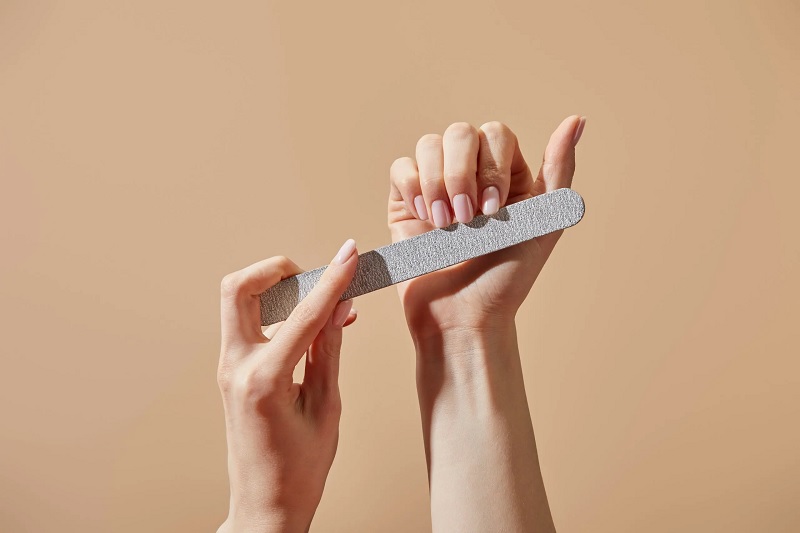
Note that the solubility of chemicals in nail products by Isopropanol depends on the kinds of acrylics. Some might swell while some might partially dissolve but the alcohol does help weaken the dips nails. In that case, you may have to use other tools like file or cuticle pusher to take out the rest.
How To Take Off Dip Powder Nails With Alcohol?
- Soak cotton ball in rubbing alcohol.
- Wrap the wet cotton ball around dip nails with aluminum foil.
- Leave your nails in the alcohol for 20-30 minutes.
- Use file or cuticle pusher to remove the softened portions since the dips don’t completely pop off.
A warning here is that Isopropyl alcohol can dry out the skin around the nail area. So, make sure to put on some moisturizer or oil after you’re done. Also, rubbing alcohol can cause skin irritation. If you notice any reaction, wash away the hands and consult a dermatologist.
5. White Vinegar
White vinegar is a good way to soften dip manis so you can remove them. Even though vinegar can weaken the structure, it can’t make the dip nails pop off. Because vinegar doesn’t have enough dissolving strength like Acetone or Alcohol to do it. However, it’s possible to make it more workable by mixing vinegar with alcohol in case there’s no acetone.
Taking off acrylic powder nails with vinegar and alcohol will be easier, quicker and more effective than doing it with just vinegar. If you opt for the latter, you may have to soak your nails in vinegar for around 60 minutes which is pretty time-consuming. So, it’s better to remove mani with the mixture.
How To Remove Dip Powder Nails With Vinegar
- Start by mixing equal parts of white vinegar and rubbing alcohol in a bowl.
- Soak the nails in the solution for 30 minutes or until they start loosening.
- Use a file to buff them down properly.
Make sure you apply the right pressure and don’t file the nails aggressively since it can scratch or scrape your enhancement or natural nails. In case you’re a beginner, go to an expert to do it for you.
Vinegar can dry out the skin too. So, putting on an oil or moisturizer is a must.
When Is The Right Time To Take Off Dip Powder Nails Without Acetone?
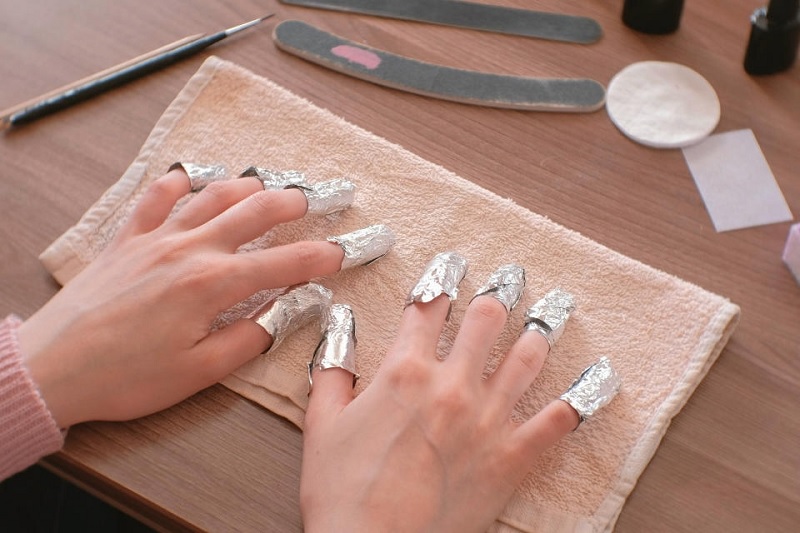
The right time to take off dip powder nails without acetone is after 2 to 3 weeks from the time you put them on.
Usually, dip mani stays up to 3 or 4 weeks. So, when you go closer to that timeframe, the acrylic powder nails will be at their sweet spot i.e weak enough to remove. They won’t be too stubborn to come off but they also won’t be ready to pop off on their own.
You can use good solvent products like acetone-free remover, rubbing alcohol or white vinegar to take out dip powder nails easily.
Frequently Asked Questions
Can Baking Soda And Toothpaste Take Off Dip Powder Nails?
No, Baking soda and toothpaste can’t take off dip powder nails because such mani is too strong to be broken down by the combo.
Besides limited efficiency, scrubbing baking soda and toothpaste can cause damage to the mani instead of removing it.
What Is The Fastest Way To Take Off Dip Nails At Home?
Using Acetone-Free Nail Polish Remover is the fastest way to take off dip nails at home in case you’re skipping Acetone.
It can take around 15-30 minutes while other methods can take anywhere from 30 to 60 minutes. All you have to do is- file the surface, then soak cotton balls in acetone-free remover and wrap them around nails with aluminum foil. That’s it.
What Is A Home Remedy For Removing Powder Nails?
White Vinegar can be an efficient home remedy for removing powder nails since it helps soften the dip nails so you can take them out. However, it can take over half an hour for the vinegar to weaken the surface. And you may need more tools like file and cuticle pusher to buff the surface and take out the dip powder nails completely.
What Is The Best Remover For Dip Nails?
Acetone is the best remover for dip nails since it’s known as a powerful solvent that can penetrate into the polymer chains of acrylic resin used in dip powder and weaken the overall structure to the point where you can take them out with ease.
Some other good alternatives can be acetone-free remover, alcohol and vinegar as they have similar dissolving properties.
Conclusion
Removing dip powder nails without acetone is possible using gentle, alternative methods that protect your natural nails. Soaking nails in warm soapy water, applying oil-based solutions like olive or coconut oil, or using white vinegar can help soften the dip powder for easy, safe removal.
Lightly buffing the top layer before soaking speeds up the process, allowing the product to loosen more effectively. While these methods may take longer than acetone, they’re far gentler on nails and skin, reducing dryness and irritation. For those wanting a natural, acetone-free option that keeps nails healthy and strong, these simple home remedies offer an effective and budget-friendly solution. Patience and care are key for the best results.

![Alternatives to Relaxers for Black Hair [Get Smooth Natural Hair]](https://landamedspa.com/wp-content/uploads/2025/05/Alternatives-to-Relaxers-for-Black-Hair-768x511.jpg)
![Best Moisturizer For Locs [Top 5 Products Explined]](https://landamedspa.com/wp-content/uploads/2025/05/Best-Moisturizer-For-Locs-768x768.jpg)
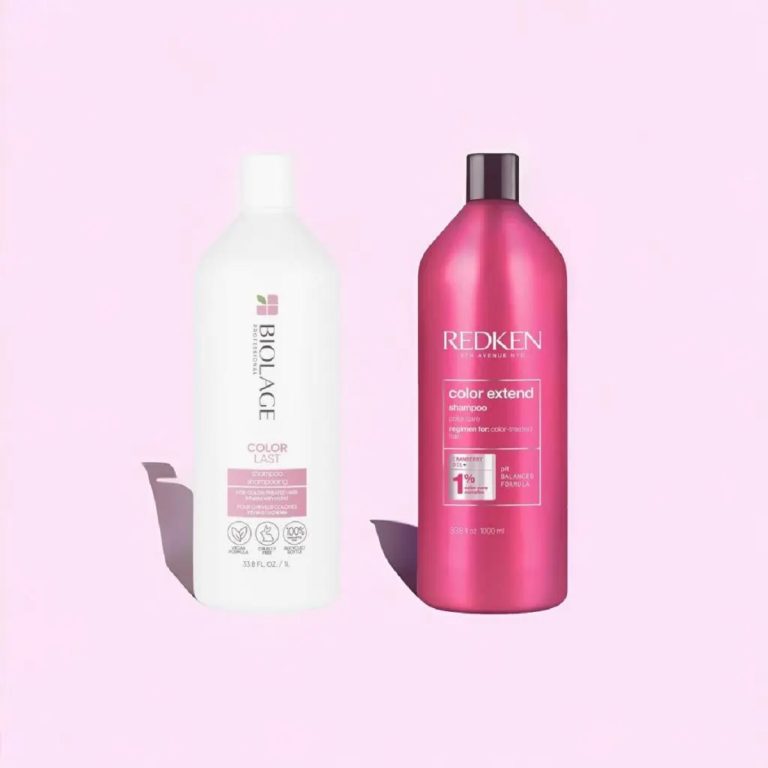
![Obagi vs. SkinCeuticals Vitamin C [Head to Head Comparison Between Them]](https://landamedspa.com/wp-content/uploads/2025/05/Obagi-vs.-SkinCeuticals-Vitamin-C-768x512.jpg)

